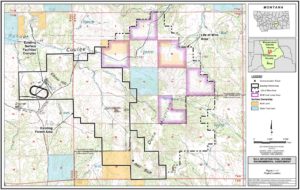By Anne Hedges

Your quiz for today: What happens when government agencies inflate the benefits of a huge coal mine expansion but ignore the fact that permitting the mine will allow it to produce coal that, when burned, will emit more greenhouse gases than the largest single source of such emissions in the nation? The answer: MEIC, our partners, and our representatives at the Western Environmental Law Center (WELC), go to court.
On April 4, 2022, that strategy paid off with a victory at the federal 9th Circuit Court of Appeals. The court ruled in our favor on our challenge to an enormous expansion at the Bull Mountain coal mine near Roundup. The proposed expansion would have made Signal Peak’s Bull Mountain mine the largest underground coal mine in the nation, and 97% of the extracted coal would be burned overseas.
The federal Office of Surface Mining (OSM) and the Montana Department of Environmental Quality (DEQ) are responsible for analyzing the impacts of mine expansion proposals before issuing permits for them, yet both agencies refuse to analyze the impacts that burning coal will have on the climate. DEQ argues that the Legislature has prevented it from analyzing such impacts. That argument is being challenged separately (see next page). In this case, OSM claimed that analyzing the mine’s climate impacts would be too difficult and uncertain. MEIC and, fortunately, the federal court, disagreed.
The federal court said that expanding the mine’s operations by 7,161 acres and mining and subsequently burning the 176 million tons of coal in the mine’s permitted area could add 190 million tons of greenhouse gases to the atmosphere (this is an underestimate). That’s roughly the equivalent of the emissions from over 37 million gas vehicles driven for a year. MEIC, 350 Montana, Sierra Club, and WildEarth Guardians, represented by WELC, challenged OSM’s decision in January 2019. We argued that it was illegal for OSM to refuse to complete an environmental impact statement under the National Environmental Policy Act and to adequately consider the impacts of the expansion on the climate crisis.
If this sounds familiar, it is. MEIC won a very similar case against OSM in 2017. In that instance, a federal district court found that OSM had “put its thumb on the scale by inflating the benefits of the action while minimizing its impacts” when it failed to analyze greenhouse gas emissions of the mine expansion.
Unfortunately, when OSM reanalyzed the climate impacts of this massive expansion, it again sidestepped the issue of the mine’s potential greenhouse gas emissions. OSM only considered the emissions from mining the coal instead of considering the climate implications of its inevitable burning. Mining only results in relatively small emissions from operating the equipment. OSM concluded that there would be no significant impact because the greenhouse gas emissions from the mine expansion were negligible when compared to global emissions.
OSM admitted in its environmental analysis that the impacts of the climate crisis are dire. It stated that “this period is now the warmest in the history of modern civilization,” and “[b]ased on extensive evidence, it is extremely likely that human activities, especially emissions of greenhouse gases, are the dominant cause of the observed warming since the mid-20th century.”
Yet, despite the accurate depiction of the climate crisis, OSM refused to consider the impacts of burning the mine’s coal. The court, in MEIC’s lawsuit, found OSM’s admission of the crisis yet dismissal of the impacts from this enormous mine expansion “deeply troubling,” adding “there is no cogent rationale that justifies excluding combustion-related emissions” from the analysis. As the court found, if OSM had compared the greenhouse gas emissions that would result when the coal from the mine was burned, it would increase Montana’s annual emissions by 519%. When spread out over time, the court found that “every year the mine expansion operates, Montana’s annual greenhouse gas emissions are expected to be about 45% greater than the state’s projected 2020 emissions.”
Once again, courts have been an important backstop for chicken-hearted regulators who acknowledge the climate crisis but don’t want to do anything about it. This case has been returned to the federal district court to determine if mining must stop while the agency completes a legally sufficient analysis.
This article was published in the June 2022 issue of Down To Earth.

